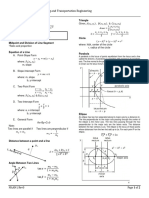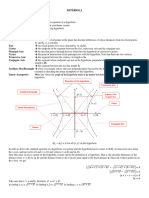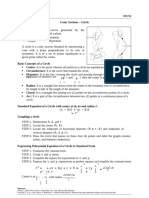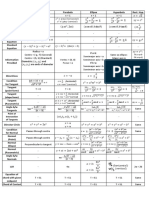0 ratings0% found this document useful (0 votes)
11 viewsPre Calculus Notes 3
Pre Calculus Notes 3
Uploaded by
Lex LabadoCopyright:
© All Rights Reserved
Available Formats
Download as PDF, TXT or read online from Scribd
Pre Calculus Notes 3
Pre Calculus Notes 3
Uploaded by
Lex Labado0 ratings0% found this document useful (0 votes)
11 views3 pagesOriginal Title
Pre Calculus Notes 3 (1)
Copyright
© © All Rights Reserved
Available Formats
PDF, TXT or read online from Scribd
Share this document
Did you find this document useful?
Is this content inappropriate?
Copyright:
© All Rights Reserved
Available Formats
Download as PDF, TXT or read online from Scribd
Download as pdf or txt
0 ratings0% found this document useful (0 votes)
11 views3 pagesPre Calculus Notes 3
Pre Calculus Notes 3
Uploaded by
Lex LabadoCopyright:
© All Rights Reserved
Available Formats
Download as PDF, TXT or read online from Scribd
Download as pdf or txt
You are on page 1of 3
CONIC SECTIONS
● HOURGLASS (VERTICAL) - Parallel
1. CIRCLE - When the plane is Horizontal to the y-axis
x= h Center (h,k)
y=k Conjugate Axis Horizontal
2 2
Distance Formula: (𝑥2 − 𝑥1)2 + (𝑦2 − 𝑦1)2 Equation Form is
(𝑦−𝑘)
𝑎
2 −
(𝑥−ℎ)
𝑏
2 =1
(𝑥2−𝑥1) (𝑦2−𝑦1) Vertices (h, k ± a )
Midpoint Formula: 2
, 2
Co-Vertices (h ± b, k)
Slope-Intercept form: y = mx+b ; m is the
negative reciprocal of the slope. Foci (h, k ± c )
𝑎
𝑦2−𝑦1 Asymptotes 𝑦 = ± 𝑏
(𝑥 − ℎ) + 𝑘
Slope of the Line: 𝑀 = 𝑥2−𝑥1 2
𝑏
Lactus Rectum 𝑎
2 2 2
Standard equation:(𝑥 − ℎ) + (𝑦 − 𝑘) = 𝑟
2 2
Transverse Length = 2a
General form: 𝐴𝑥 + 𝐵𝑦 + 𝐶𝑥 + 𝐷𝑦 + 𝐸 = 0,
𝑤ℎ𝑒𝑟𝑒 𝑎 𝑖𝑠 𝑛𝑜𝑡 𝑒𝑞𝑢𝑎𝑙 𝑡𝑜 0. 3. PARABOLA-
Solve the radius in tangent x-axis or y-axis by Vertex : origin V (0, 0) If the parabola
counting based on the given axis. opens upward, the vertex is the
Completing the square. lowest point. If the Parabola opens
(Note: both sides should be equally added) downward, The vertex is the
In an equation, if A is not equal to 1, make Highest point.
sure to factor out leaving the standard Directrix : the line y = −c or y = c
equation reduced. When adding to the other The directrix is c units below or above
side,don’t forget to multiply the used factor. the vertex.
System of linear equations by using Focus: F(0, c) or F(0, −c) The focus is
substitution to find out the value of x and y. c units above or below the Vertex. Any
When it has a diameter with endpoints use point on the parabola has the same
the Distance Formula. distance from the focus as it has from
the directrix.
2. HYPERBOLA - when the plane (not necessarily
Axis of symmetry: x = 0 (the y-axis)
vertical) intersect both cones to form two unbounded
This line divides the parabola into two
curves (each called a branch of the hyper-bola)
parts which are mirror images of each
other.
● BUTTERFLY (HORIZONTAL) - parallel to
the x-axis
FORMULA VERTEX AT ORIGIN
2
Center (h,k) 𝑥 = 4𝑎𝑦 𝑜𝑝𝑒𝑛𝑠 𝑢𝑝𝑤𝑎𝑟𝑑
2 2
(𝑥−ℎ) (𝑦−𝑘) 2
Equation form is 2 + 2 = 1 𝑥 = − 4𝑎𝑦 𝑜𝑝𝑒𝑛𝑠 𝑑𝑜𝑤𝑛𝑤𝑎𝑟𝑑
𝑎 𝑏
2
Transverse Axis = Horizontal 𝑦 = − 4𝑎𝑥 𝑜𝑝𝑒𝑛𝑠 𝑡𝑜 𝑡ℎ𝑒 𝑙𝑒𝑓𝑡
2
Transverse Length = 2a 𝑦 = 4𝑎𝑥 𝑜𝑝𝑒𝑛𝑠 𝑡𝑜 𝑡ℎ𝑒 𝑟𝑖𝑔ℎ𝑡
Conjugate Axis = Vertical
Conjugate Length = 2b FORMULA VERTEX AT (H,K)
2
vertex (ℎ ± 𝑎, 𝑘) (𝑥 − ℎ) = 4𝑎 (𝑦 − 𝑘) 𝑢𝑝𝑤𝑎𝑟𝑑
2
Co-vertex (ℎ, 𝑘 ± 𝑏) (𝑥 − ℎ) =− 4𝑎 (𝑦 − 𝑘) 𝑑𝑜𝑤𝑛𝑤𝑎𝑟𝑑
Foci (ℎ ± 𝑐, 𝑘) (𝑦 − 𝑘)
2
=− 4𝑎 (𝑥 − ℎ) 𝑜𝑝𝑒𝑛𝑠 𝑡𝑜 𝑡ℎ𝑒 𝑙𝑒𝑓𝑡
𝑏
Asymptotes 𝑦 = ± (𝑥 − ℎ) + 𝑘 2
𝑎 (𝑦 − 𝑘) = 4𝑎 (𝑥 − ℎ) 𝑜𝑝𝑒𝑛𝑠 𝑡𝑜 𝑡ℎ𝑒 𝑟𝑖𝑔ℎ𝑡
2 2 2
Pythagorean theorem: 𝑎 + 𝑏 = 𝑐
EQUATION: CENTER AT ORIGIN
2
● (𝑥 − ℎ) = 4𝑎 (𝑦 − 𝑘) 𝑢𝑝𝑤𝑎𝑟𝑑 2
𝑥 𝑦
2
Horizontal: 2 − 2 =1
Focus: (h, k+a) 𝑎 𝑏
2 2
Directrix: y= k-a Vertical:
𝑦
−
𝑥
=1
2 2
2 𝑎 𝑏
● (𝑥 − ℎ) =− 4𝑎 (𝑦 − 𝑘) 𝑑𝑜𝑤𝑛𝑤𝑎𝑟𝑑
CENTER AT H,K
Focus: (h, k-a) 2 2
(𝑥−ℎ) (𝑦−𝑘)
Directrix: y= k+a Horizontal: 2 − 2 =1
𝑎 𝑏
2
● (𝑦 − 𝑘) = 4𝑎 (𝑥 − ℎ) 𝑜𝑝𝑒𝑛𝑠 𝑡𝑜 𝑡ℎ𝑒 𝑟𝑖𝑔ℎ𝑡 (𝑦−𝑘)
2
(𝑥−ℎ)
2
Vertical: − =1
Focus:( h+ a,k)
2 2
𝑎 𝑏
Directrix: x= h-a Vertex: (h, k ± a )
●
2
(𝑦 − 𝑘) =− 4𝑎 (𝑥 − ℎ) 𝑜𝑝𝑒𝑛𝑠 𝑡𝑜 𝑡ℎ𝑒 𝑙𝑒𝑓𝑡 Covertex: (ℎ ∓ 𝑐, 𝑘)
Focus: (h-a, k) Foci: (ℎ, 𝑘 ± 𝑏)
Directrix: x= h+a
EASILY IDENTIFYING CONIC SECTIONS:
NOTE: Circle: When x and y are both squared
-The equations are in terms of x − h and y − k: the and The coefficients on them are the same
vertex coordinates are subtracted from the —including the sign.
corresponding variable. Thus, replacing both h and Parabola: When either x or y is squared —
k with 0 would yield the case where the vertex is the not both.
origin. For instance, this replacement applied to Ellipse: When x and y are both squared
2
(x−h) = 4c(y−k) (parabola opening upward) would and the coefficients are positive but
2 different.
yield 𝑥 = 4cy, the first standard equation we
Hyperbola: When x and y are both
encountered (parabola opening upward, vertex
squared, and exactly one of the coefficients
at the origin).
is negative and exactly one of the
coefficients is positive.
-If the x-part is squared, the parabola is “vertical”; if
the y-part is squared, the parabola is “horizontal.” In
METHODS OF SOLVING SYSTEMS OF LINEAR
a horizontal parabola, the focus is on the left
EQUATIONS FOR TWO VARIABLES
or right of the vertex, and the directrix is vertical.
Substitution method
-If the coefficient of the linear (non-squared) part is
● First, solve one linear equation for
positive, the parabola
y in terms of x .
opens upward or to the right; if negative, downward
● Then substitute that expression for y in the
or to the left.
other linear equation. You'll get an equation
in x .
3. ELLIPSE
● Solve this, and you have the x-coordinate
In the standard equation, if the x-part has the bigger of the intersection.
denominator, the ellipse is horizontal. If the y-part has ● Then plug in x to either equation to find the
bigger denominator, the ellipse is vertical. corresponding y -coordinate. (If it's easier,
When the (tilted) plane intersects only one cone to you can start by solving an equation for x in
form a bounded curve terms of y, also – same difference!)
a is always greater than b
Graphing method
2 2 ● If we want to solve a system of linear
(𝑥−ℎ) (𝑦−𝑘)
2 + 2 =1 equations by this method, we must know
𝑎 𝑏
that the graph of each linear equation is the
line.
● We graph both the equations by finding values −𝑦
for 'y' for different values of 'x' in the coordinate 𝑎1𝑐2−𝑎2𝑐1
system. Once it is done, we find the point of
intersection of these two lines. ● Finally, we consider the expression
below 1, which is 𝑎 𝑏 − 𝑎 𝑏
1 2 2 1
Linear Combination Method (Addition method)
● To write this, we ignore the column of
● Solve the system
constants, and cross-multiply the
● Multiply the first equation by adding the
coefficients in the remaining two
result to the second equation.
columns, and subtract them: Thus, the
● Solve for y
last part of our solution
● Substitute for y in either of the original
equality becomes
equations and solve for x
1
Cross Multiplication Method 𝑎1𝑏2−𝑎2𝑏1
● To solve linear equations with two
variables, we use the cross multiplication ● Combining all the three parts, our
formula: complete solution to the pair of linear
𝑥 −𝑦 1 equations becomes:
𝑏2𝑐2−𝑏2𝑐1
= 𝑎1𝑐2−𝑎2𝑐1
= 𝑎1𝑏2−𝑎2 𝑥 −𝑦 1
𝑏2𝑐2−𝑏2𝑐1
= 𝑎1𝑐2−𝑎2𝑐1
= 𝑎1𝑏2−𝑎2𝑏1
● To understand this technique, consider
an arbitrary pair of linear equations (that 𝑥 −𝑦 1
is, with any coefficients)
● ?
= ?
= ?
(a)1x + (b)1y + (c)1 = 0 𝑑𝑒𝑛𝑜𝑚𝑖𝑛𝑎𝑡𝑜𝑟 𝑜𝑓 𝑥
● 𝑥= 𝑑𝑒𝑛𝑜𝑚𝑖𝑛𝑎𝑡𝑜𝑟 𝑜𝑓 1
(a)2x + (b)2y + (c)2 = 0
𝑑𝑒𝑛𝑜𝑚𝑖𝑛𝑎𝑡𝑜𝑟 𝑜𝑓 𝑦
● Let us write down the coefficients in the ● 𝑦= 𝑑𝑒𝑛𝑜𝑚𝑖𝑛𝑎𝑡𝑜𝑟 𝑜𝑓 1
original pair of equations as follows, in a
Matrix Method
grid fashion ● The first step is to convert this into a matrix.
(a)1 (b)1 (c)1 Make sure all equations are in standard form
(Ax+By=C) , and use the coefficients of each
(a)2 (b)2 (c)2 equation to form each row of the matrix. It
● We now will simply ignore the coefficients may help you to separate the right column
of x in our grid, and cross-multiply the with a dotted line.
coefficients in the remaining two ● Next, we use the matrix row operations to
columns, and subtract them: change the 2×2 matrix on the left side to the
identity matrix .
𝑥
𝑏2𝑐2−𝑏2𝑐1 METHODS OF SOLVING SYSTEMS OF
● Next, we consider the expression below LINEAR EQUATIONS
negative y, which is 𝑎 𝑐 − 𝑎 𝑐
1 2 2 1
● Cramer's method-
To write this, we ignore the column of y
coefficients, and cross-multiply the ● Inverse method-
coefficients in the remaining two ● Gauss-Jordan method
columns, and subtract them: ● Gauss Elimination method
Thus, the second part of our solution ● LU Decomposition method of factorisation (or)
equality becomes, Method of Triangularisation
You might also like
- Hyperbola Week 5: Content StandardsDocument12 pagesHyperbola Week 5: Content StandardsJackylyn FalejoNo ratings yet
- Pre Cal S1Q1 Reviewer - AllDocument3 pagesPre Cal S1Q1 Reviewer - AllSunNo ratings yet
- Summary and Bound ReferenceDocument33 pagesSummary and Bound Referenceshauryasaxena888No ratings yet
- 6024methods-units-1-and-2-exam-notesDocument3 pages6024methods-units-1-and-2-exam-notesMedi MridulNo ratings yet
- Center: Pre-Calculus GuideDocument7 pagesCenter: Pre-Calculus GuideLovEegnia BalbuenaNo ratings yet
- ME-430-MATH-ANALGEOMDocument15 pagesME-430-MATH-ANALGEOM20-02590No ratings yet
- Mat061 Chapter 2Document40 pagesMat061 Chapter 2Enaira100% (1)
- Analytic Geometry (11-21)Document4 pagesAnalytic Geometry (11-21)blueberrytimeNo ratings yet
- Precalculus Reviewer PDFDocument5 pagesPrecalculus Reviewer PDFAnnel Christine RamosNo ratings yet
- Pre CalDocument3 pagesPre CalLeon NyNo ratings yet
- Plane and Spherical TrigonometryDocument5 pagesPlane and Spherical TrigonometryDwight SolinaNo ratings yet
- Precal11 Las q1w4lc8 9Document8 pagesPrecal11 Las q1w4lc8 9cjcmrenz16No ratings yet
- Analytic Geometry 1 - OnlineDocument2 pagesAnalytic Geometry 1 - OnlineNox ThalgicNo ratings yet
- Hyperbola Dehay VelasquezDocument5 pagesHyperbola Dehay VelasquezImSalty LOLNo ratings yet
- 1A CER1 Analytic GeometryDocument2 pages1A CER1 Analytic GeometryJenie EscandorNo ratings yet
- Ib SL Maths Summary NotesDocument43 pagesIb SL Maths Summary Notesmohammmed irshadNo ratings yet
- Add Maths RevisionDocument17 pagesAdd Maths Revisionmohammmed irshadNo ratings yet
- Mathematics ReviewerDocument6 pagesMathematics ReviewerJared AlexanderNo ratings yet
- LESSON 4.1 Ellipse With Center HKDocument11 pagesLESSON 4.1 Ellipse With Center HKjarenhndsm.placiegoNo ratings yet
- Pre Cal Reviewer Q1Document7 pagesPre Cal Reviewer Q1Kenneth ComabigNo ratings yet
- SAT Math Cheat SheetDocument8 pagesSAT Math Cheat Sheetaarav100% (1)
- FUNCTIONSDocument9 pagesFUNCTIONSxboxliveforlessmoneyNo ratings yet
- Precal Q1 M2 W2Document12 pagesPrecal Q1 M2 W2destroyer kingNo ratings yet
- PrecalQ1 Module 5 Conics Solution of Non Linear EquationsDocument21 pagesPrecalQ1 Module 5 Conics Solution of Non Linear EquationsMary VillanuevaNo ratings yet
- HyperbolaDocument4 pagesHyperbolaRhasher YbañezNo ratings yet
- Level K: Equations of Quadratic FunctionsDocument6 pagesLevel K: Equations of Quadratic FunctionsVishal Kunnathur SenthilkumarNo ratings yet
- 10.3: Hyperbolas: I. DefinitionsDocument2 pages10.3: Hyperbolas: I. Definitionsmohammed aliNo ratings yet
- s6 05-09-18 - Study Guide-Linear FunctionsDocument2 pagess6 05-09-18 - Study Guide-Linear FunctionsMarisa Vetter100% (1)
- Mathematics: Ax + by + C 0 y MX + B, y - y M (YDocument12 pagesMathematics: Ax + by + C 0 y MX + B, y - y M (Yvzimak2355No ratings yet
- SAT Math Cheat Sheet STTV 2020Document8 pagesSAT Math Cheat Sheet STTV 2020Vuong HoangNo ratings yet
- Finding The Inverse Reflection Using Transformation Table of ValuesDocument3 pagesFinding The Inverse Reflection Using Transformation Table of ValuesPuneet SehgalNo ratings yet
- HyperbolaDocument41 pagesHyperbolaGS NegiNo ratings yet
- Ia Lol XDDDDDDocument13 pagesIa Lol XDDDDDBillan LiaoNo ratings yet
- Analytic Geometry 1Document2 pagesAnalytic Geometry 1ggomo15100% (1)
- Analytic Geometry 1Document2 pagesAnalytic Geometry 1Wayne VillarozaNo ratings yet
- Analytic GeometryDocument7 pagesAnalytic GeometrymammasddNo ratings yet
- PreCal Q1 Lesson 5 HyperbolaDocument2 pagesPreCal Q1 Lesson 5 HyperbolaAlliah Richely Mae CruzNo ratings yet
- 01 - CIRCLE - DoneDocument2 pages01 - CIRCLE - DoneCynthia FranyNo ratings yet
- Functions Revision BookletDocument58 pagesFunctions Revision Bookletm07shele2No ratings yet
- Deleted Part of Class 11-MathsDocument3 pagesDeleted Part of Class 11-MathssidrxshrafNo ratings yet
- Graphing A Quadratic FunctionDocument4 pagesGraphing A Quadratic FunctionAbo MoussaNo ratings yet
- Lesson 4: Hyperbola Objectives:: Hyperbola With Horizontal Transverse AxisDocument2 pagesLesson 4: Hyperbola Objectives:: Hyperbola With Horizontal Transverse AxisGlaiza Pacatang BaldosNo ratings yet
- Reviewer For GeometryDocument2 pagesReviewer For GeometryAlice AsmodeusNo ratings yet
- Pre Calculus ReviewerDocument2 pagesPre Calculus ReviewerhaloserkickNo ratings yet
- Learning Module Week 6 in Math 411 PDFDocument11 pagesLearning Module Week 6 in Math 411 PDFAllyzzaNo ratings yet
- Q1 LAS W4 HyperbolaDocument4 pagesQ1 LAS W4 HyperbolaShandy ManabatNo ratings yet
- Q1 W2 PrecalculusDocument11 pagesQ1 W2 PrecalculusArianne MolinaNo ratings yet
- 1stQtr Pre Calculus ReviewerDocument3 pages1stQtr Pre Calculus ReviewerGanyu da SecretaryNo ratings yet
- PRE CAL ReviewerDocument5 pagesPRE CAL RevieweralfonsoclarissemanaloNo ratings yet
- Analytic Geometry 2Document2 pagesAnalytic Geometry 2ggomo15100% (1)
- Solution To Extra Problem Set 2Document9 pagesSolution To Extra Problem Set 2物理系小薯No ratings yet
- Math 2b Study GuideDocument12 pagesMath 2b Study Guideelliea10045No ratings yet
- Coordinate GeometryDocument16 pagesCoordinate GeometrySLNo ratings yet
- PreCal 1 NotesDocument20 pagesPreCal 1 NotesMark JimenezNo ratings yet
- Functions Last PushDocument56 pagesFunctions Last Pushvanessamahlatse81No ratings yet
- Conic Sections Parabola NotesDocument4 pagesConic Sections Parabola NotescdnmejanNo ratings yet
- Formula Cheat SheetDocument2 pagesFormula Cheat SheetFrances CabanigNo ratings yet
- A-level Maths Revision: Cheeky Revision ShortcutsFrom EverandA-level Maths Revision: Cheeky Revision ShortcutsRating: 3.5 out of 5 stars3.5/5 (8)
- Student Solutions Manual to Accompany Economic Dynamics in Discrete Time, second editionFrom EverandStudent Solutions Manual to Accompany Economic Dynamics in Discrete Time, second editionRating: 4.5 out of 5 stars4.5/5 (2)
- Transformation of Axes (Geometry) Mathematics Question BankFrom EverandTransformation of Axes (Geometry) Mathematics Question BankRating: 3 out of 5 stars3/5 (1)
- Grade 12: National Senior CertificateDocument7 pagesGrade 12: National Senior CertificateWonder Bee NzamaNo ratings yet
- Trig TableDocument1 pageTrig TableAb BaNo ratings yet
- Quant Master Session - TGs Geometry II For CAT-12 PDFDocument2 pagesQuant Master Session - TGs Geometry II For CAT-12 PDFGunjan SolankiNo ratings yet
- selfstudys_com_file (1)Document173 pagesselfstudys_com_file (1)lorinpriyamduttaNo ratings yet
- NCERT Solutions For Class 10 Maths Chapter 6 Triangles Exercise 6.3Document14 pagesNCERT Solutions For Class 10 Maths Chapter 6 Triangles Exercise 6.3krishan murariNo ratings yet
- Vectors PracticeDocument8 pagesVectors PracticeDennis Junior ChorumaNo ratings yet
- 07 Maths Key Notes Ch7 Congruence of TrianglesDocument2 pages07 Maths Key Notes Ch7 Congruence of TrianglesMahesh KushwahaNo ratings yet
- A Generalization of The Droz-Farny Line Theorem With Orthologic TrianglesDocument4 pagesA Generalization of The Droz-Farny Line Theorem With Orthologic TrianglesDũng Nguyễn TiếnNo ratings yet
- Circle Theorems ChapterDocument24 pagesCircle Theorems ChapterRaghuCheenepalle50% (2)
- Gen Ed MATHDocument9 pagesGen Ed MATHArnel Jr Ambrocio100% (1)
- Differentiation (Maximum and Minimum Value)Document26 pagesDifferentiation (Maximum and Minimum Value)Bisma RajaNo ratings yet
- Engineering DrawingDocument8 pagesEngineering DrawingJohn Riccel CaredoNo ratings yet
- Math F2 QSDocument8 pagesMath F2 QSEnoch KurrNo ratings yet
- Isometric DrawingDocument2 pagesIsometric DrawingAllen IcaonapoNo ratings yet
- Iugaza Tom2012 - CH1-5Document95 pagesIugaza Tom2012 - CH1-5Sagar PawarNo ratings yet
- Kinema TicsDocument30 pagesKinema Ticsthinkiit100% (1)
- UNIT 8 Lesson 8.1 Grade 7Document49 pagesUNIT 8 Lesson 8.1 Grade 7areen fakhouryNo ratings yet
- Plane Geometry Practice Problems Part1 2015Document11 pagesPlane Geometry Practice Problems Part1 2015mekeleweng100% (1)
- QB GeometryandTrig LinesAnglesandTriangles AnsDocument74 pagesQB GeometryandTrig LinesAnglesandTriangles AnsCitinhaNo ratings yet
- PolygonsDocument5 pagesPolygonsmkhantareen78No ratings yet
- X-Sample Paper (UTS-09 by O.P. GUPTA)Document8 pagesX-Sample Paper (UTS-09 by O.P. GUPTA)Uma SundarNo ratings yet
- Previous Exams Questions Ch23-24-With NotesDocument11 pagesPrevious Exams Questions Ch23-24-With NotesaamerbolookiNo ratings yet
- 3rd Periodical Test in MathDocument7 pages3rd Periodical Test in MathEliza CunananNo ratings yet
- Problem 2.1: SolutionDocument161 pagesProblem 2.1: SolutionFernanda MorenoNo ratings yet
- Gr. 6 Diagnostic Answer KeyDocument9 pagesGr. 6 Diagnostic Answer KeytrishNo ratings yet
- Math Competition 2008Document32 pagesMath Competition 2008Rusdin La EbaNo ratings yet
- Solid State Physics I - PPT (Repaired)Document159 pagesSolid State Physics I - PPT (Repaired)davididosa40No ratings yet
- Penrith 2022 Year 9 Maths Yearly & SolutionsDocument28 pagesPenrith 2022 Year 9 Maths Yearly & Solutionsrosiele7007No ratings yet
- Nov 2021 Mat F2Document20 pagesNov 2021 Mat F2notguest90No ratings yet
- Assignment - 4 Projection of SolidsDocument2 pagesAssignment - 4 Projection of SolidsLeenaNo ratings yet

























































































